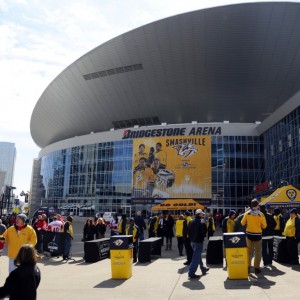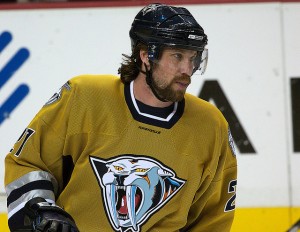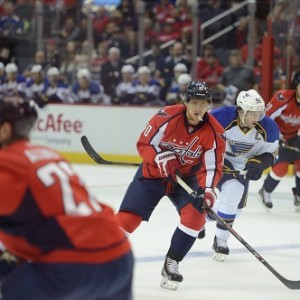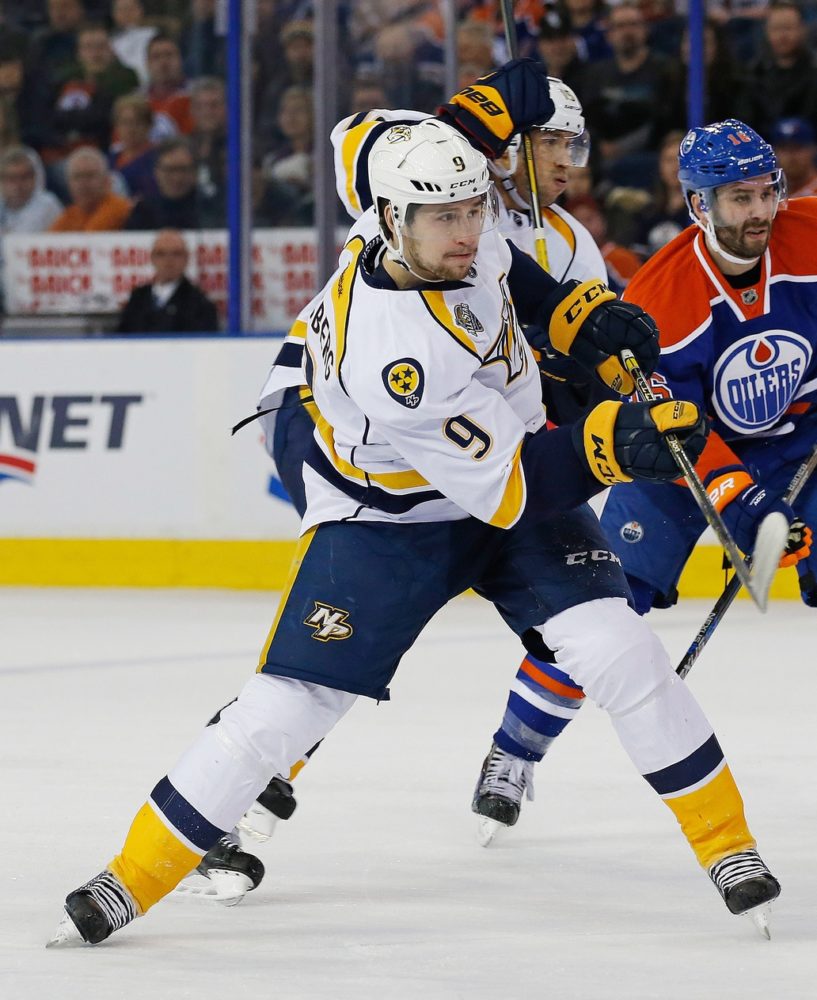Trades—every GM makes them and are one of the key indicators that define how “good” a GM is. Similarly to the draft, determining the quality of the trade tends to take a few seasons to fully show the value. It is always fun playing “Captain Hindsight” and looking at the winners and losers of an organization’s trade history.
Predators’ General Manager David Poile has a long history of making great trades that have helped build and improve the Predators. Early on in the Predators’ history, Poile built the team through stockpiling draft picks and trying to lure quality players in free agency. This strategy worked well and quickly the Predators became one of the top teams in their division. Ultimately, from a quick glance many would believe that Poile is one of the most respected GM’s within the NHL. So, what are the best and worst trades in Poile’s history in Nashville?
Setting the Stage for Failure
It is hard to label this trade the “worst” merely because I understand the intentions from Poile. Despite forming a winning team early in the organization’s existence, Poile struggled to get an attendance and fan interest that supported the talented team. In fact, according to ESPN and going back to the 2001-02 season and extending to 2010-11, the Predators finished in the bottom five of the league almost every season. Many of those seasons saw them averaging between 14,000-15,500 fans per game.

Looking at 2011-12 extending to this season, they still have yet to break into the top 20 but that is no longer because of a lack of community support. Currently, the reason the Predators will always struggle to break into the top 20 is because their arena only seats 17,113. This season is the first season they have ever had an average attendance above capacity at 100.2 % with 17,148 per game and they are 20th in the league.
The situation in 2006-07 was dire in Nashville as the season before saw an average paid attendance of 13,815. In fact, Scott Burnside a Senior Writer for ESPN wrote, “The Predators need to see the average paid attendance reach the 14,000 mark this season or the team’s owners, whoever they might be by the end of next season, can pay a penalty and exit the current lease with the city of Nashville (at least that’s the theory, although some city officials insist it’s not that simple).”
The Worst Predators Trade in History
In the 2006-07 season, the Predators were first in their division going into the trade deadline and Poile needed desperately to make a splash. Poile decided to bring in Peter Forsberg, an NHL legend who was in the last year of his contract with the Philadelphia Flyers. Despite Forsberg’s foot and ankle injuries, Poile decided that it was worth the gamble and would also help a team that struggled to make any noise in the Stanley Cup Playoffs.

In fact, Poile stated, “”It’s certainly, I think, a clear message also to our community that we are aiming to be the best that we can be, and we certainly hope this translates to … more fan support in our community.” While the intentions and goal to increase fan awareness were certainly admirable, the Flyers took full advantage of the Predators attendance woes.
The price for Peter Forsberg was Scottie Upshall, Ryan Parent, and a 2007 first and third round pick. At the time, Scottie Upshall was considered a hot prospect, as he was the sixth overall pick in the 2002 draft. In addition, Ryan Parent was a top defensive prospect who was drafted 18th in the 2005 NHL draft.
The trade might not have been as bad if Forsberg had of re-signed with the Predators. However, after only playing in 22 total games in a Predators uniform, he signed in Colorado. Essentially, the Predators gave up three first round picks and a third for Forsberg to walk in free agency that summer — it is easy to say the Flyers took Poile “to the cleaners.”
When it Rains, it Pours
The woes from the Forsberg trade extended past the initial loss of players directly involved in the trade. The Predators were on a tight budget and decided to trade again with the Flyers for their 2007 first round pick before the NHL draft. The Flyers were more than willing to listen to the Predators as they also possessed the second overall pick in that summer.

Poile decided that the Predators wouldn’t have the ability to sign Forsberg, Kimmo Timonen and Scott Hartnell before they all entered free agency on July 1st, 2007. As a result, Poile traded the rights to Predators Captain and arguably best player, Kimmo Timonen, with 24-year-old Scott Hartnell for their previously traded 2007 first round pick.
Looking at the players, Kimmo Timonen amassed just over 300 points in eight seasons with the Predators. In fact, looking at the value of Timonen, when the Flyers traded Timonen at 39 years-old to the Blackhawks they received two second round picks in the 2015 NHL Draft and a fourth-round conditional 2016 NHL Draft pick. Scott Hartnell was selected sixth overall in the 2000 NHL draft and was a top-six forward on any NHL team at 24. Thus, the Flyers essentially received Scottie Upshall, Ryan Parent, Kimmo Timonen, Scott Hartnell and a third round pick while loaning Forsberg to the Predators for 22 games.
The Best Poile Trade
Ironically, the best trade by Poile shares the last name of his worst trade—Forsberg. Poile caught a Washington team at the trade deadline in the 2012-13 season that was desperate to add a “key piece.” Poile scored by trading veteran Martin Erat and Michael Latta for coveted youngster Filip Forsberg.
This trade is potentially the “Worst” in Capitals history, as well as ex-GM George McPhee’s career. The minute this trade was made many in the hockey world began scratching their head.

At the time, Forsberg was the Capitals’ 11th pick in the 2012 NHL Draft and the top prospect in the organization. What was most crazy was that all the scouts and management were on board as McPhee was quoted saying, “I make them vote independently without any influence. Write it out, put it on a piece of paper, and then I read through [their responses]. It was unanimous to do it.”
When current Capitals GM Brian McLellan was asked about the trade later, he stated, “I think [Forsberg] has played well. Obviously he’s one of the leading candidates for the Calder Trophy. If you’re asking if I would like to do a do-over? Yeah, sure.”
To add salt to the wound was that Erat missed the Caps post-season run with an injury. Furthermore, he then asked for a trade early in the 2013-14 season and was dealt close to the trade deadline. In addition, his tough cap hit and “log-jamming” an already crowded offensive roster was a key part to the Caps sending away another young and talented prospect for “nothing,”as they traded Mathieu Perreault.
Forsberg as a Predator

Going into the 2013-14 season, the Predators and Poile were certain that Forsberg was an amazing acquisition. He went from 21st on the Future Watch the year before, to being listed as the fourth best and even had a vote for the best overall. As Matt Larkin from The Hockey News noted, “Projections aren’t everything, but it’s worth noting at least one expert considers Forsberg the best prospect in the world and this prospect was traded for…Martin Erat.”
Filip Forsberg didn’t take long to start turning heads as he put up 34 points (15g, 19a) in 47 games in the AHL. The last two seasons with the Predators, he has registered 63 and 64 points in 2014-15 and 2015-16. To say the least, Forsberg has become one of the top young forwards in the NHL with his production.
Last season, he scored 33 goals and tied the Predators single-season goal record. His production in three seasons with Nashville resulted in them considering him a long-term factor for the future. Most teams who have similar young and producing prospects are able to negotiate a “bridge deal.” Nashville elected to skip that deal and rewarded him with a six-year, $36 million contract.
This season continues to see Forsberg produce at significant levels for the Predators. While his production has slowed a little at the beginning of the season, I am confident he will eclipse the 60-point threshold again. To say the least, the trade for Forsberg was easily one of the best in Poile’s career and the Predators history.